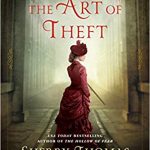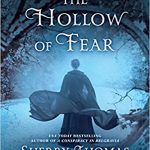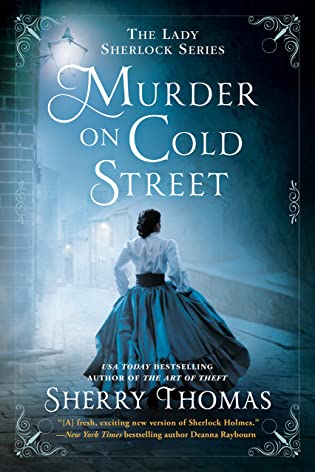 Murder on Cold Street (Lady Sherlock, #5) by Sherry Thomas
Murder on Cold Street (Lady Sherlock, #5) by Sherry Thomas Format: eARC
Source: supplied by publisher via NetGalley
Formats available: hardcover, large print, paperback, ebook, audiobook
Genres: historical fiction, historical mystery
Series: Lady Sherlock #5
Pages: 352
Published by Berkley Books on October 6, 2020
Purchasing Info: Author's Website, Publisher's Website, Amazon, Barnes & Noble, Kobo, Bookshop.org
Goodreads
Charlotte Holmes, Lady Sherlock, is back solving new cases in the USA Today bestselling series set in Victorian England.
Inspector Treadles, Charlotte Holmes’s friend and collaborator, has been found locked in a room with two dead men, both of whom worked with his wife at the great manufacturing enterprise she has recently inherited.
Rumors fly. Had Inspector Treadles killed the men because they had opposed his wife’s initiatives at every turn? Had he killed in a fit of jealous rage, because he suspected Mrs. Treadles of harboring deeper feelings for one of the men? To make matters worse, he refuses to speak on his own behalf, despite the overwhelming evidence against him.
Charlotte finds herself in a case strewn with lies and secrets. But which lies are to cover up small sins, and which secrets would flay open a past better left forgotten? Not to mention, how can she concentrate on these murders, when Lord Ingram, her oldest friend and sometime lover, at last dangles before her the one thing she has always wanted?
My Review:
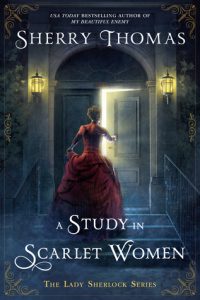 Welcome to another captivating AND frustrating entry in the Lady Sherlock series. And I really do mean both parts of that.
Welcome to another captivating AND frustrating entry in the Lady Sherlock series. And I really do mean both parts of that.
The series as a whole, and this particular entry in it, provides a fascinating look at an alternative version of Sherlock Holmes, and I’m always a sucker for a good Holmes pastiche, which this series definitely is.
The alternate Sherlock explored by this series is one where Sherlock Holmes is the entirely fictitious invalid brother of the “real” detective, Charlotte Holmes.
And that’s where both the genius and the frustration of this series comes in. It’s not that Charlotte is female, it’s that Charlotte has to deal with all of the frustrations and restrictions that come with living while female – and in the Victorian Era to boot, when those restrictions were even more ridiculously restrictive than they sometimes are today.
Making Charlotte’s life an endless series of situations that she has to work her way around. Her workarounds – like the fictitious invalid brother – are an absolute necessity. And that’s what makes reading this series so endlessly frustrating. The reader wants her to be able to just “get on with it” and she literally can’t if she is to remain a true – albeit atypical – creature of her time.
The social obligations and restrictions don’t really bother her, but they definitely bother other people when she doesn’t at least nod in their direction. So it’s both right and annoying at the same time. (Obviously I’d have done very poorly as a middle-class Victorian woman!)
What makes this particular case so fascinating is that the case, in its entirety, seems to be hedged about with all of the issues that, well, hedged women about, even though both the victims and the accused perpetrator are men.
 Inspector Treadles, who serves as Charlotte’s Inspector Lestrade, meaning that Treadles is the Scotland Yard detective who both assists and is assisted by Charlotte, and who therefore gets to take the official credit for the cases she solves, has been accused of murder. Considering that he was found standing over two dead bodies inside a locked room with his service revolver in his hand, it is not surprising that he was assumed to be the killer.
Inspector Treadles, who serves as Charlotte’s Inspector Lestrade, meaning that Treadles is the Scotland Yard detective who both assists and is assisted by Charlotte, and who therefore gets to take the official credit for the cases she solves, has been accused of murder. Considering that he was found standing over two dead bodies inside a locked room with his service revolver in his hand, it is not surprising that he was assumed to be the killer.
Particularly as he didn’t seem to have anything to say that would explain the circumstances. Mrs. Treadles comes to Sherlock Holmes in desperation, hoping against hope that the great detective will not just come to the aid of his colleague, but will be able to extricate his head from the seemingly inevitable hangman’s noose.
But Treadles has held himself distant from Holmes, after discovering that Charlotte, a mere woman, was the real detective. And he’s held himself distant from his poor wife ever since she inherited her family’s manufacturing business from her late brother.
It seems as if Treadles’ unwillingness to accept either his wife’s or his “colleague’s” ability to be both female and intelligent is at the heart of this case. One of the murder victims was his wife’s mentor, and the other is rumored to have been her lover.
He has too many motives and seemingly no defense whatsoever. It will be up to Charlotte, with the able assistance of her own band of irregulars, Mrs. Watson, Miss Redmayne and especially Lord Ashburton, to figure out the truth.
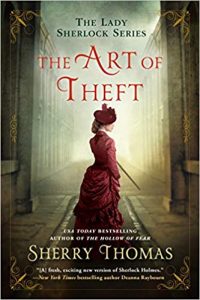 Escape Rating B: As should be clear by now, I feel a bit of a push-pull about Charlotte. She fits her time – more or less – and her time is frustrating. One of the interesting things about this particular entry in the series is the way that Lord Ashburton is beginning to understand just how privileged he is, not in the sense that he is a privileged member of the upper class, although he certainly is, but that his movements through the world are eased immeasurably simply because he is a man.
Escape Rating B: As should be clear by now, I feel a bit of a push-pull about Charlotte. She fits her time – more or less – and her time is frustrating. One of the interesting things about this particular entry in the series is the way that Lord Ashburton is beginning to understand just how privileged he is, not in the sense that he is a privileged member of the upper class, although he certainly is, but that his movements through the world are eased immeasurably simply because he is a man.
His consciousness of that fact feels a bit ahead of his time, but not unduly so. But it does serve to highlight just how many restrictions Charlotte – and by extension for this particular case, Mrs. Treadles – has to deal with.
The heart of this case is both simple and complex. On the one hand, there’s the financial malfeasance that is finally uncovered. And on the other, there’s that huge undercurrent that swirls around just how fragile a woman’s place in the world can be, and how easy it is for an unscrupulous man – or simply an unthinking or uncaring one – to make a woman’s life a misery of recriminations and blame even if she hasn’t put a single step wrong.
This made the mystery fascinating. It was fairly obvious that Inspector Treadles’ silence was intended to protect someone from something, but protect who from what was the darkest part of the mystery until near the end. That ALL of the goings-on in the place where he was found turned out to be a nearly impenetrable farce just added to the stew of red herrings in the case.
But five books in, I’m seeing a pattern that, well, tasks me. It feels like the circle is much too close, too centered on Charlotte. There should be more cases that aren’t so personal if Charlotte is operating as a consulting detective. But so far, all of the cases have centered around people close to her; her parents (A Study in Scarlet Women), her half brother (A Conspiracy in Belgravia), Lord Ashburton himself (The Hollow of Fear), Mrs. Watson (The Art of Theft) and now Inspector Treadles. There should be some cases that don’t have such high emotional stakes.
Each of the individual cases has been interesting, but the entire world shouldn’t revolve around Charlotte. Or it feels that way. Definitely on another hand, having that world revolve around Moriarty, as it also does, feels right. At the same time, it also feels like the solution that Charlotte Holmes comes up with for her final Moriarty problem is likely to end the series.
And as much as Charlotte and her world drive me a bit crazy, I don’t want that to be anytime soon.












